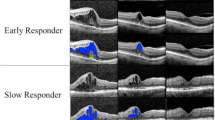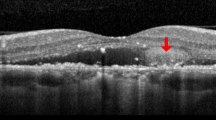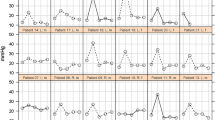Abstract
Purpose
Vasculogenic mimicry patterns, formed by highly invasive melanoma cells, connect to endothelial cell-lined blood vessels and contain fluid in vitroand in vivo. This study was designed to determine if fluid leaks into vasculogenic mimicry patterns without circulation, or if fluid circulates in and clears from these patterns.
Methods
Indocyanine green (ICG) laser scanning confocal angiography (Heidelberg Retinal Angiograph (HRA); Heidelberg Engineering, Heidelberg, Germany) was performed on nine patients with posterior choroidal melanoma in an institutional setting. Blood was drawn before the ICG injection and from the contralateral arm of the ICG injection site and 1 min after the injection. Outcome measures include time to first filling of retinal vessels and vasculogenic mimicry patterns and the time at which no fluorescence could be detected by the HRA instrument. After fluorescence was no longer detected in vessels or patterns, the tubes containing the patient's blood was imaged by the Heidelberg HRA.
Results
Looping vasculogenic mimicry patterns were detected focally in five patients within 30 s after injection and were detectable up to 12 min post-injection. Blood drawn before ICG injection did not autofluoresce but ICG-containing blood pooled in the tube continued to fluoresce at 1-month post-injection.
Conclusions
Vasculogenic mimicry patterns are not part of the endothelial cell-lined vascular system and fluid enters these patterns through leakage. The rapid infusion of ICG into these patterns after injection and the disappearance of fluorescence detectable by the Heidelberg HRA suggest that fluid circulates in these patterns and does not accumulate as a stagnant pool.
Similar content being viewed by others
Log in or create a free account to read this content
Gain free access to this article, as well as selected content from this journal and more on nature.com
or
References
Clarijs R, Schalkwijk L, Ruiter DJ, de Waal RMW . Lack of lymphangiogenesis despite coexpression of VEGF-C and its receptor Flt-4 in uveal melanoma. Invest Ophthal Vis Sci 2001; 42: 1422–1428.
Chen X, Maniotis AJ, Majumdar D, Pe'er J, Folberg R . Uveal melanoma cell staining for CD34 and assessment of tumor vascularity. Invest Ophthalmol Vis Sci 2002; 43: 2533–2539.
Maniotis AJ, Folberg R, Hess A, Seftor EA, Gardner LMG, Pe'er J et al. Vascular channel formation by human melanoma cells in vivo and in vitro: vasculogenic mimicry. Am J Pathol 1999; 155: 739–752.
Maniotis AJ, Chen X, Garcia C, DeChristopher PJ, Wu D, Pe'er J et al. Control of melanoma morphogenesis, endothelial survival, and perfusion by extracellular matrix. Lab Invest 2002; 82: 1031–1043.
Clarijs R, Otte-Holler I, Ruiter DJ, de Waal RM . Presence of a fluid-conducting meshwork in xenografted cutaneous and primary human uveal melanoma. Invest Ophthalmol Vis Sci 2002; 43: 912–918.
Lin AY, Maniotis AJ, Valyi-Nagy K, Majumdar D, Setty S, Kadkol S et al. Distinguishing fibrovascular septa from vasculogenic mimicry patterns. Arch Pathol Lab Med 2005; 129: 884–892.
Hao XS, Sun BC, Zhang SW, Zhao XL . Correlation between the expression of collgen IV, VEGF and vasculogenic mimicry. Zhonghua Zhong Liu Za Zhi 2003; 25: 524–526.
Daniels KJ, Boldt HC, Martin JA, Gardner LM, Meyer M, Folberg R . Expression of Type VI collagen in uveal melanoma: role in pattern formation and tumor progression. Lab Invest 1996; 75: 55–66.
Potgens AJG, van Altena MC, Lubsen NH, Ruiter DJ, de Waal RMW . Analysis of the tumor vasculature and metastatic behavior of xenografts of human melanoma cell lines transfected with vascular permeability factor. Am J Pathol 1996; 148: 1203–1217.
Smetsers TFCM, van de Westerlo EMA, ten Dam GB, Clarijs R, Versteeg EM et al. Localization and characterization of melanoma-associated glycosaminoglycans: Differential expression of chondroitin and heparan sulfate epitopes in melanoma. Cancer Res 2003; 63: 2965–2970.
Clarijs R, van Dijk M, Ruiter DJ, de Waal RMW . Functional and morphologic analysis of the fluid-conducting meshwork in xenografted cutaneous and primary uveal melanoma. Invest Ophthalmol Vis Sci 2005; 46: 3013–3020.
Freeman WR, Bartsch DU, Mueller AJ, Banker AS, Weinreb RS . Simultaneous indocyanine green and fluorescein angiography using a confocal scanning laser ophthalmoscope. Arch Ophthalmol 1998; 116: 455–463.
Mueller AJ, Bartsch DU, Folberg R, Mehaffey MG, Boldt HC, Meyer M et al. Imaging the microvasculature of choroidal melanomas with confocal indocyanine green scanning laser ophthalmoscopy. Arch Ophthalmol 1998; 116: 31–39.
Folberg R, Rummelt V, Parys-Van Ginderdeuren R, Hwang T, Woolson RF, Pe'er J et al. The prognostic value of tumor blood vessel morphology in primary uveal melanoma. Ophthalmology 1993; 100: 1389–1398.
Sakamoto T, Sakamoto M, Yoshikawa H, Hata Y, Ishibashi T, Ohnishi Y et al. Histologic findings and prognosis of uveal malignant melanoma in Japanese patients. Am J Ophthalmol 1996; 121: 276–283.
Schaling DF, van der Pol JP, Schlingemann RO, Parys-Van Ginderdeuren R, Jager MJ . In: Schaling DF. (ed) Vascular density and vascular patterns in the prognosis of choroidal melanoma. In: Radionucleotides and Radiolabelled Antibodies in Choroidal Melanoma (Diagnosis and Therapy). Rijksuniversiteit te Leiden: Leiden, 1996.
McLean IW, Keefe KS, Burnier MN . Uveal melanoma: comparison of the prognostic value of fibrovascular loops, mean of the ten largest nucleoli, cell type and tumor size. Ophthalmology 1997; 104: 777–780.
Seregard S, Spangberg B, Juul C, Oskarsson M . Prognostic accuracy of the mean of the largest nucleoli, vascular patterns, and PC-10 in posterior uveal melanoma. Ophthalmology 1998; 105: 485–491.
Makitie T, Summanen P, Tarkkanen A, Kivela T . Microvascular density in predicting survival of patients with choroidal and ciliary body melanoma. Invest Ophthalmol Vis Sci 1999; 40: 2471–2480.
Scholes AGM, Damato BE, Nunn J, Hiscott P, Grierson I, Field JK . Monosomy 3 in uveal melanoma: Correlation with clinical and histologic predictors of survival. Invest Ophthalmol Vis Sci 2003; 44: 1008–1011.
Prescher G, Bornfeld N, Hirche H, Horsthemke B, Jockel KH, Becher R . Prognostic impliations of monosomy 3 in uveal melanoma. Lancet 1996; 347: 1222–1225.
Onken MD, Lin AY, Worley LA, Folberg R, Harbour JW . Association between microarray gene expression signature and extravascular matrix patterns in primary uveal melanomas. Am J Ophthalmol 2005; 140: 748–749.
Mueller AJ, Schaller U, Freeman W, Folberg R, Kampik A . Complex microcirculation patterns detected by confocal indocyanine green angiography predict time to growth of small choroidal melanocytic tumors. MuSIC-Report II. Ophthalmology 2002; 109: 2207–2214.
McDonald DM, Munn L, Jain RK . Vasculogenic mimicry: how convincing, how novel, and how significant? Am J Pathol 2000; 156: 383–388.
Chen X, Ai Z, Rasmussen M, Bajcsy P, Auvil L, Welge M et al. Three-dimensional reconstruction of extravascular matrix patterns and blood vessels in human uveal melanoma tissue: techniques and preliminary findings. Invest Ophthalmol Vis Sci 2003; 44: 2834–2840.
Lin AY, Ai Z, Lee SC, Bajcsy P, Pe'er J, Leach L et al. Comparing vasculogenic mimicry with endothelial cell lined vessels: techniques for 3D reconstruction and quantitative analysis of tissue components from archival paraffin blocks. Appl Immunohistochem Mol Morphol 2007; 15: 113–119.
Acknowledgements
Supported by National Eye Institute Grant EY10457 (RF) and EY016323 (DUB).
Author information
Authors and Affiliations
Corresponding author
Additional information
Presented in part at the 2006 ARVO meeting (E-Abstract 1494). Fort Lauderdale, Florida, USA
Rights and permissions
About this article
Cite this article
Frenkel, S., Barzel, I., Levy, J. et al. Demonstrating circulation in vasculogenic mimicry patterns of uveal melanoma by confocal indocyanine green angiography. Eye 22, 948–952 (2008). https://doi.org/10.1038/sj.eye.6702783
Received:
Accepted:
Published:
Issue date:
DOI: https://doi.org/10.1038/sj.eye.6702783
Keywords
This article is cited by
-
N-myc downstream–regulated gene 1 can promote vasculogenic mimicry and angiogenesis in urothelial carcinoma
Virchows Archiv (2024)
-
Glioblastoma vasculogenic mimicry: signaling pathways progression and potential anti-angiogenesis targets
Biomarker Research (2015)
-
A pilot histomorphology and hemodynamic of vasculogenic mimicry in gallbladder carcinomas in vivo and in vitro
Journal of Experimental & Clinical Cancer Research (2011)
-
Tumor angiogenesis: molecular pathways and therapeutic targets
Nature Medicine (2011)
-
Tumour vascularization: sprouting angiogenesis and beyond
Cancer and Metastasis Reviews (2007)



